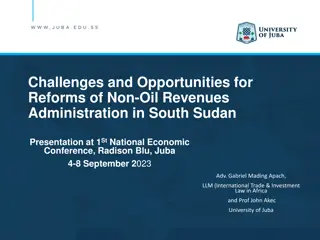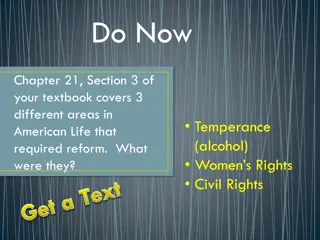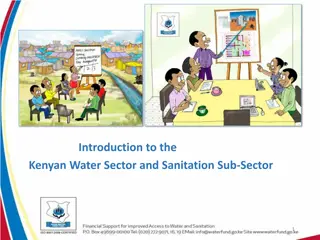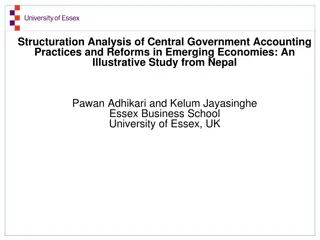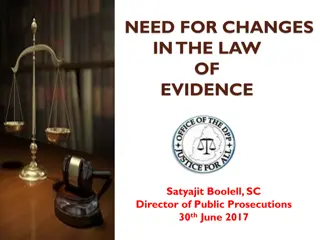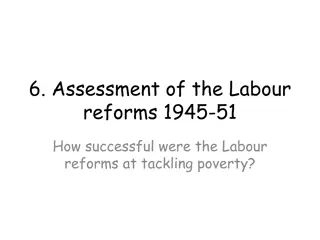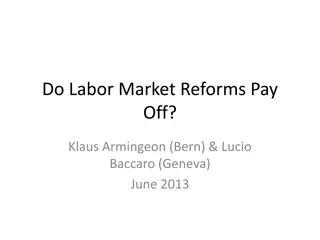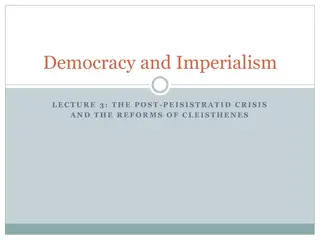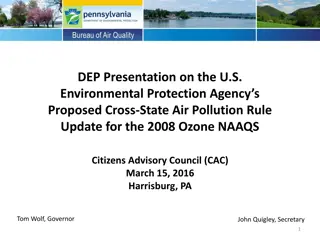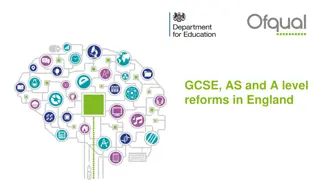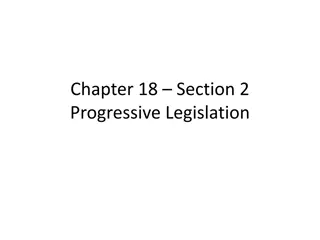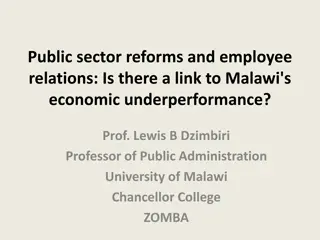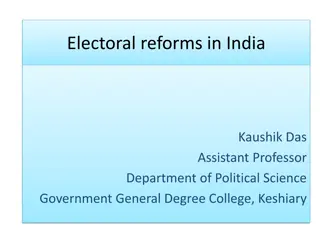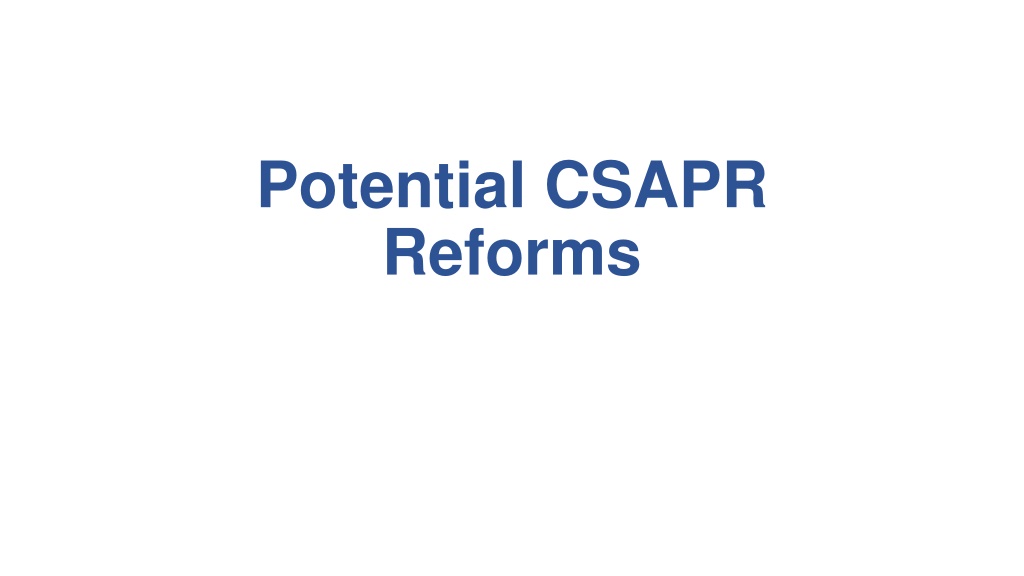
Potential Reforms for CSAPR in Addressing Ozone NAAQS
Explore potential reforms EPA could consider in a CSAPR for the 2015 ozone NAAQS, such as establishing a multi-tier structure, adjusting state budgets based on emissions contributions, and more. Legal justifications and policy designs are also outlined.
Download Presentation

Please find below an Image/Link to download the presentation.
The content on the website is provided AS IS for your information and personal use only. It may not be sold, licensed, or shared on other websites without obtaining consent from the author. Download presentation by click this link. If you encounter any issues during the download, it is possible that the publisher has removed the file from their server.
E N D
Presentation Transcript
Potential CSAPR Reforms
Reforms that EPA could consider in a CSAPR for the 2015 ozone NAAQS Establish multi-tier structure Determine budgets based on different cost thresholds, depending on the level of a state s contribution to downwind nonattainment. Account for unscheduled retirements in annual state budgets Remove allowances equivalent to a retired unit s allocation from the budget. Control for oversupply of banked allowances Adjust the bank annually to prevent oversupply, or eliminate carryover of allowances from the previous CSAPR and/or year-to-year banking in the new CSAPR. Restrict interstate trading of allowances Constrain or completely disallow trading of allowances between states.
Establishing multiple tiers Policy design Set budgets for states that are higher contributors to downwind issues based on controls at a higher cost-per- ton threshold: Develop state budgets based on the control efficacy identified in traditional knee-in-the-curve analysis. If modeled downwind nonattainment or maintenance issues persist, focus on subset of upwind states with large pre-control linkages (e.g., > 2 ppb contribution) to those remaining downwind monitors. For this subset, EPA could establish budgets based on a higher cost-per-ton threshold. Legal justification Using a single cost threshold perpetuates under-control by forgoing additional emission reductions from states contributing most to persistent nonattainment or maintenance issues. EPA could continue to apply the traditional factors in determining a state s significant contribution including abatement costs, emission reductions, and air quality improvements as well as the degree to which a state contributes to downwind nonattainment.
Accounting for unscheduled retirements Policy design Annually adjust state budgets to reflect emission reductions (or increases) from unscheduled retirements (or additions) of electric generating units: Option A: Stop allocating allowances to a retired unit immediately & remove those allowances from the state budget. Option B: Continue allocating allowances to a retired unit for a few years & remove equivalent allowances from a set-aside within the state budget. Add allowances to the state budget for unscheduled additions (obviating the New Unit Set Aside). Legal justification Would be consistent with EPA s previous rationale for accounting for emission reductions from scheduled retirements: ensuring that each state eliminates its significant contribution by deploying cost-effective controls at the current fleet of EGUs. Under the current approach, emission reductions from unscheduled retirements may vastly overcompensate for emission increases from unscheduled additions, weakening the rule and necessitating revisions.
Annually adjusting banked allowances Policy design For each set of states at a given cost threshold, after each ozone season, apply an adjustment factor to the banked allowances in each account to reduce the total number of banked allowances to the sum of the variability limits within the set of states. Legal justification Could lessen the risk of exceeding assurance levels by foreclosing a large surplus of allowances. Annually adjusting the size of the bank could maintain market liquidity without jeopardizing effectiveness.
Eliminating banked allowances Policy design Prohibit sources from using allowances issued in a previous program and/or in a previous control period. Provide alternative forms of compliance flexibility, potentially: Could create a reserve of allowances available at a premium, up to the state s assurance level. Legal justification Could lessen the risk of exceeding assurance levels by foreclosing a large surplus of allowances. Carrying over allowances from a program based on a lower cost threshold could exacerbate this risk. There may be sufficient incentive, without banking, for early reductions of emissions with tighter budgets. Using banked allowances does not achieve the public-health objectives of a seasonal ozone program. Cost-control reserve could send a stronger price signal to regulated sources as to the need to remain within the budget than would a large bank of unused allowances that may sell at a low price.
Restricting interstate trading Policy design Option A: Allow interstate trading across all sources participating in the program. Option B: Restrict interstate trading to sources within states at the same cost threshold. Option C: Prohibit interstate trading. Legal justification Option A: Allowing trading across all sources could prompt more emission reductions in states with budgets based on lower cost thresholds. Option B: Restricting trading to sources within states at the same cost threshold would reduce the risk of exceeding assurance levels in states with more-stringent budgets. Prevents transfers of allowances from lower-contributing states to higher-contributing states, which are mostly located in one region and affect receptors with the worst ozone problems. Option C: There is no statutory requirement to permit trading among sources in different states. Congress envisioned that each state would address its significant contribution.
Illustration of the potential reforms in action Year 1 initial budget total Unscheduled retirements & additions in Year 1 Year 1 adjusted budget total Total emissions in Year 1 Banked allowances following Year 1 Adjusted banked allowances from Year 1 Red states 1,500 + 250 - 500 1,250 750 500 263 (= 21% x 1,250) Yellow states 2,000 + 100 - 200 1,900 1,700 200 200 (< 21% x 1,900) Year 2 initial budget total Unscheduled retirements & additions in Year 2 Year 2 adjusted budget total Total emissions in Year 2 Banked allowances following Year 2 Adjusted banked allowances from Year 2 Red states 1,250 - 100 1,150 600 813 (= 263 + 1,150 - 600) 242 (= 21% x 1,150) Yellow states 1,900 + 200 2,100 1,600 700 (= 200 + 2,100 - 1,600) 441 (= 21% x 2,100)



